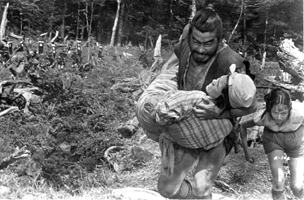

Japan action
1958
bw 139 min.
Director: Akira Kurosawa
CLV: out-of-print collectible
3 discs, catalog # CC1384L
VHS: available from Home Vision Cinema

One
of the greatest action-adventure films ever made, The Hidden Fortress
stands alongside the finest achievements of its creator -- Japanese film master
Akira Kurosawa. Produced in 1958, this thrilling Cinemascope epic -- starring
Kurosawa's favorite actor Toshiro Mifune -- is set squarely within the traditions
of the Japanese film genre known as the "Chambara."Costume and swordplay epics
set in the 16th-century feudal period, "Chambara" films mix history and folklore
with the conventions of theatrical melodrama much as American westerns do. And
like the majority of westerns, most "Chambara" films are "programmers" -- routine
action "quickies" ground out like so many sausages and tossed out on the movie
marketplace. In the hands of the man who made such films as Rashomon,
Ikiru, Yojimbo and Ran, however, genre particulars appear as
anything but routine. Fast-paced, witty and visually stunning, The Hidden
Fortress has delighted audiences not only on its home turf, but throughout
the world -- something few "Chambara" films ever managed to do.
At heart the
story is a simple one. Having escaped the clutches of an enemy clan, Princess
Yuki (Misa Uehara), her loyal retainers, and her faithful military commandant,
General Rokurota Makabe (Toshiro Mifune), are hiding out in a secret mountain
fortress. With their clan's precious gold horde hidden in sticks of firewood,
they plan to make their escape across a nearby border by disguising themselves as
peasants. Once on their way, it's one chase, swordfight, and hairs-breadth escape
after another.
Straightforward as this seems on paper, this same scenario
unfolds in a somewhat oblique manner on screen. For rather than deal with his
heroes directly, Kurosawa elects to tell their story through the eyes of two
minor characters -- a pair of peasant farmers that the Princess Yuki and the
General use to aid their escape.
Matashichi (Kamatari Fujiwara) and Tahei
(Minoru Chiaki) live on the lowest possible level of the feudal totem pole.
They're entirely at the mercy of whatever miliary faction is currently holding
sway. Threatened with death at one moment, forced into slavery at another, their
lives are one long process of victimization. Still these pieces of peasant
flotsam and jetsam aren't noble sufferers. Constantly bickering between
themselves, they're as corrupt as their exploiters. When they discover the clan
gold, they leap on it like starving animals -- each claiming sole ownership
rights.
For the Princess and the General, this greed proves useful. They need
help in carrying the gold across the border. With troops on the lookout for them,
the peasants will provide something of a disguise. Matashichi and Tahei, for
their part, have no idea who the Princess and the General are, and are only too
glad to help. Blinded by greed, they plot to steal the gold along the escape
route. Part Shakespearean clowns, part Laurel and Hardy, the pair's antics
provide both a "worm's eye view" of history, and form a backdrop for Kurosawa's
particular take on certain aspects of Japanese tradition -- which is at once both
celebratory and critical. Kurosawa clearly revels in the high adventure of the
story he's telling, and the excitement of the era it reflects. But such enjoyment
doesn't rule out criticism of the feudal honor code's loyalty unto-death ideals.
The General's defense of the Princess comes at the cost of the life of his own
sister. Likewise, the peasant farmers' antics may be amusing, but the desperation
of their situation is nevertheless made real.
Serious as these grace notes are,
they're minor in terms of the film's overall plan. For The Hidden Fortress
is first and foremost a flat-out "pure entertainment" in the grand tradition --
and a stunning demonstration of the visual power of the wide-screen film. The
battle on the steps in Chapter 2 (anticipating the climax of Ran) is as visually
overwhelming as any of the similar scenes in Griffith's Intolerance. The use of
composition in depth in the fortress scene in Chapter 4 is likewise as arresting
as the best of Eisenstein or David Lean. Toshiro Mifune's muscular demonstrations
of heroic derring-do in the horse-charge scene (Chapter 11) and the scrupulously
choreographed swordfight climax that follows it (Chapter 12) is in the finest
tradition of Douglas Fairbanks. Overall, there's a sense of sheer "movieness" to
The Hidden Fortress that places it plainly in the ranks of such grand
adventure-entertainments as Gunga Din, The Thief of Baghdad, and
Fritz Lang's celebrated diptych The Tiger of Eschnapur and The Hindu
Tomb.
But as much as it's part of one tradition, The Hidden Fortress
can also lay claim to starting one of its own. The "worm's eye view" of its story
is taken up by Sergio Leone for his meta-westerns, The Good, the Bad and the
Ugly and Once Upon a Time in the West. Kurosawa's action set pieces
likewise reappear in a slightly different guise in Raiders of the Lost Ark
and Indiana Jones and the Temple of Doom (Indy's whip replacing Makabe's
sword). Most important of all, there's Star Wars. George Lucas has himself
acknowledged his debt to Kurosawa for much of the scenario of his space opera in
which a Princess (Leia) and soldier (Han Solo) escaped from enemy forces with the
help of two bickering "peasant farmer" robots -- R2D2 and C3PO. It was fun, but
for some of us it can't hold a candle to the original adventure "a long time ago"
in a land "far far away."
May the "Chambara" be with you! -- DAVID
EHRENSTEIN
Credits
Director: Akira Kurosawa
Producer: Masumi
Fujimoto, Akira Kurosawa
Screenplay: Ryuzo Kikushima, Hideo Oguni, Shinobu
Hashimoto, Akira Kurosawa
Cinematography: Kazuo Yamasaki
Lighting: Ichiro
Inohara
Art Direction: Yoshiro Muraki, Kohei Ezaki
Sound: Fumio
Yanoguchi
Music: Masaru Sato
Transfer
This edition of The
Hidden Fortress was transferred from a 35mm master print.





